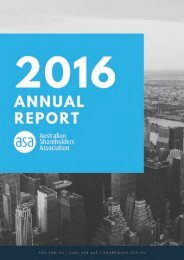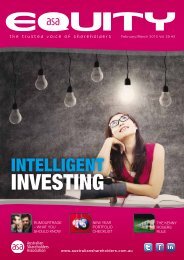eq-2014-12
eq-2014-12
eq-2014-12
Create successful ePaper yourself
Turn your PDF publications into a flip-book with our unique Google optimized e-Paper software.
Lifting the game with<br />
shareholder engagement<br />
By Ian Curry, Chairman, Australian Shareholders’ Association<br />
For many years the main forum for directors to engage with<br />
shareholders has been the annual general meeting (AGM).<br />
More recently, there has been considerable discussion about<br />
the role of the AGM and its continued relevance. Whilst it<br />
is true that attendance levels at the annual gathering has<br />
dwindled over time, shareholders continue to want to be<br />
heard and it remains important that companies acknowledge<br />
the significance of providing retail shareholders with an<br />
appropriate forum to do so.<br />
The Australian director-shareholder relationship is unique in<br />
that engagement has unquestionably resulted in changes<br />
to corporate governance and remuneration practices. As<br />
the Australian Council of Superannuation Investors recently<br />
reported, the median take home salary of chief executive<br />
officers has decreased in the past year. The ASA has also<br />
witnessed changes to executive remuneration arrangements<br />
which are generally reflective of longer-term alignment with<br />
the interests of shareholders, which we see as the result of<br />
a trend towards shareholders acting more like owners and<br />
boards responding by becoming more engaged.<br />
It is important for companies to continue to focus on<br />
improving the dialogue with shareholders and the AGM<br />
experience for retail shareholders. More often, we are seeing<br />
directors speaking to their elections at AGMs and companies<br />
providing a simple question form with the notice of meeting<br />
which shareholders can submit ahead of an AGM. The ASA<br />
was extremely pleased to see ASX provide attendees at<br />
its AGM in September <strong>2014</strong> with copies of consolidated<br />
responses to commonly asked investor questions. This<br />
shows that companies are keen to listen and actively engage<br />
with shareholders. For example, in some, the responses from<br />
ASX indicated that ASX was minded to consider changes<br />
to its practices and policies raised in the questions.<br />
Companies are increasingly under pressure to make their<br />
communications clearer and more relevant to readers. Annual<br />
reports, company filings and other disclosure documents<br />
should be written with the intended audience in mind, rather<br />
than simply providing the r<strong>eq</strong>uired legal disclosures and<br />
assuming that no reader will ever get through the content.<br />
Readers should not have to sift through pages of materials<br />
to look for the information that is relevant to their decision<br />
to invest or disinvest in the company. As an example, banks<br />
and managed funds often include many pages of individual<br />
transactions in their substantial shareholding notices. It<br />
is true that these are included at the end of the lengthy<br />
disclosures, but that information ought not be included<br />
unless absolutely r<strong>eq</strong>uired and in any case, thought should<br />
be put into presenting the information in a manner that is<br />
useful to the reader. At some point, market practices will<br />
need to be reconsidered in this regard.<br />
ASA believes companies should also turn their minds to<br />
providing information to shareholders in a timelier manner. In<br />
September <strong>2014</strong>, the ASA reported on the companies which<br />
reported their half-year and full-year results on the last day<br />
possible. Disclosing financial results and the remuneration<br />
report earlier means that investors have ample time to review<br />
that information and make better informed decisions about<br />
their investments.<br />
The ASA is seeing more companies wishing to engage with<br />
not only institutional investors but also retail investors. We are<br />
fr<strong>eq</strong>uently contacted by companies to arrange discussions<br />
about corporate governance and remuneration issues and<br />
directors are keen to be involved with smaller-scale events<br />
involving retail investors. The ASA has organised a number<br />
of successful site tours of ASX companies over the past<br />
two years, with feedback consistently indicating that the<br />
tours helped investors better understand the companies<br />
which they essentially owned.<br />
Stronger and better communication leads to more<br />
effective engagement and better informed investors. This<br />
applies to face-to-face interactions, public disclosures<br />
and investor information provided on company websites.<br />
Communications should be prepared with all audiences in<br />
mind including institutional investors, super funds and retail.<br />
Important information about the company and its policies<br />
should be readily available on a company’s website.<br />
Going forward, we would like to see increased engagement<br />
with shareholders via less formal forums and on a more<br />
regular basis. There is no reason why retail shareholders<br />
could not be invited to and encouraged to attend investor<br />
briefings and we would encourage companies to embrace<br />
technology to allow more people to attend and participate<br />
in AGMs (eg use of webcasting), as opposed to denying<br />
those not as technologically literate their right to participate<br />
in activities of interest to shareholders.<br />
It is one thing to advocate that the AGM has become less<br />
relevant and should be abandoned. But the more important<br />
question then is, what alternative will provide an ad<strong>eq</strong>uate<br />
forum for retail investors to communicate their views to<br />
those whom they have entrusted to run their company<br />
The challenge is and will be for companies to find better<br />
ways of engaging with shareholders.<br />
This article was first published in the ASX publication titled Listed@ASX.<br />
EQUITY December <strong>2014</strong> Page 16




